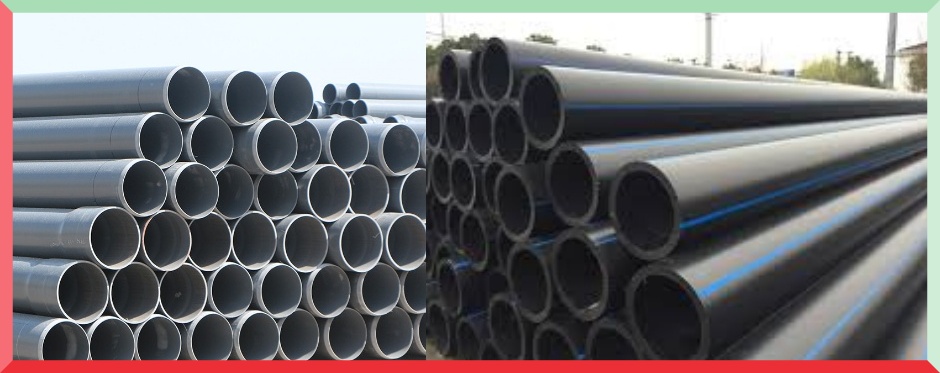
The two common types of plastic pipes used in irrigation are HDPE and PVC.
Both pipes share many similarities, but they also have distinct differences, each with its own strengths, weaknesses, and use cases.
This guide compares HDPE vs. PVC pipes to help you determine the best choice for your needs.
What Is HDPE Pipe?
HDPE, short for High-Density Polyethylene, is a type of thermoplastic piping system known for its strength, flexibility, impermeability, and suitability for high-pressure pipelines
HDPE pipes are mainly used for industrial purposes to transport fluids, wastewater, oil, or gas.
In fact, this reliable and durable material often replaces metallic or concrete pipelines in these applications.
What Is PVC Pipe?
PVC is also made from the synthetic plastic named Polyvinyl chloride.
PVC is best suitable for underground systems, and PVCs have higher tensile strength than HDPE pipes.
PVC is best suitable for plumbing, irrigation, water supply networks, drainage systems, and many other applications.
PVC pipes and HDPE pipes have some common characteristics that make them a preferred choice for a wide array of applications. Both are.
- Made of plastic.
- Lightweight.
- Resistant to Corrosion.
- Resistant to bacterial and chemical build-up.
- Have a higher life expectancy than metallic pipes.
Now, let’s explore the major differences that set HDPE and PVC apart.
Differences Between HDPE and PVC
Manufacturing Process
PVC is made out of polyvinyl chloride, a plastic that is made by combining chlorine and ethylene.
The pipe is strong and rigid due to the addition of impact modifiers during production, making it less susceptible to stress cracking and impact damage.
HDPE pipe is made from polyethylene thermoplastic derived from petroleum.
The high heat melts the HDPE into a liquid that can be poured into a mold. Once cooled, it solidifies into a tough material. Less impact modifying additives are needed in HDPE pipes than in PVC.
Durability
PVC has strength and good impact resistance, considered as best suitable for the underground water supply. However, over time, it can leach out, causing the pipe to become brittle. The performance and life expectancy of PVC pipes depend on adding the right plasticizers and preventing leaching.
Whereas HDPE is considered to be a durable pipe; that can withstand events like rain, stress, wind, heat, or cold, HDPE is proven to be more durable.
Chemical Resistance
PVC can handle many chemicals easily, such as sulfuric acid, though it exhibits poor oxidation resistance in harsh conditions over time. PVC pipes are suitable for applications involving the transport of aggressive fluids
HDPE also handles many chemicals successfully, including solutions with 2-10% sulfuric acid concentrations, sodium hydroxide, brine solutions, and more, making it effective for transporting various substances through pipelines.
Joining
You can easily join PVC using the glue or gasket when there is a leakage or any tampering.
In contrast, HDPE pipes can only be joined through heat fusion. While PVC pipe fittings can be joined underwater, HDPE cannot. But HDPE pipes can withstand and dampen more shock waves compared to PVC.
Temperature Rating
Continuous exposure to the sun and heat hinge durability.
The maximum temperature at which PVC can retain its strength and performance is 140° F.
On the other hand, HDPE is serviceable in environments from -70° up to 180° F in most cases, without the physical performance declining substantially.
Installation
HDPE pipes can be installed in many ways like.
- Open trench
- Directional bore
- Horizontal bore
- Drop burial
However, PVCs are installed in the following.
- Open trench.
- Drop burial.
Irrigation
PVC pipes are considered the best for irrigation due to their ease of installation and maintenance. For enhanced durability, it is recommended to bury PVC pipes.
HDPE pipes are becoming increasingly popular, especially in areas where digging is challenging or impossible; HDPE is the preferred choice.
Flexibility
PVC pipes are not flexible, making it difficult to bend them. Extra fittings or cutting may be required for installation.
In the case of HDPE, you don’t need any extra fittings. HDPE pipes can bend; this flexibility allows for easier installation.This flexibility simplifies installation, particularly in applications where pipes need to follow curved paths or adapt to changing ground conditions.
Environmental Impact
Considering the impact on the environment, PVC pipe is considered harmful because of substances like chlorine, a potentially harmful substance used in PVC manufacturing. Additionally, PVC pipes are not easily recyclable.
HDPE pipe is considered as environmentally friendly compared to PVC because HDPE is a recyclable material, and the recycling process of HDPE pipes has lower environmental impact.
Cost
Finally, it all comes down to the cost and how expensive both pipes are.
Well, PVCs are cost effective and available at low cost compared to HDPE.
In my personal experience, I recently needed both pipes for my farm, and HDPE cost me three times more than PVC.
Last Words…
Now, you are aware of the differences between PVC and HDPE. Each has its own set of advantages and disadvantages, making one more suitable for specific scenarios than the other.
For instance, the chlorinated composition of PVC pipes provides initial strength but renders them susceptible to cracks, leaks, and breaks as additives deplete and oxidation embrittles the material over time. On the other hand, HDPE, with its higher purity and resistance to chemicals and temperature extremes, emerges as a more suitable choice for demanding infrastructure needs.
So, in the end, it all comes down to your need and budget and what’s your planning, long term or short term?

Leave a Reply